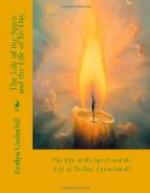But if we believe that the permanent objective of the spirit is God—if He be indeed for us the Fountain of Life and the sum of Reality—can we acquiesce in these forms of loss? Surely it ought to be our first aim, to make the sense of His universal presence and transcendent worth, and of the self’s responsibility to Him, dominant for the plastic youthful consciousness confided to our care: to introduce that consciousness into a world which is really a theocracy and encourage its aptitude for generous love? If educationists do not view such a proposal with favour, this shows how miserable and distorted our common conception of God has become; and how small a part it really plays in our practical life. Most of us scramble through that practical life, and are prepared to let our children scramble too, without any clear notions of that hygiene of the soul which has been studied for centuries by experts; and few look upon this branch of self-knowledge as something that all men may possess who will submit to education and work for its achievement. Thus we have degenerated from the mediaeval standpoint; for then at least the necessity of spiritual education was understood and accepted, and the current psychology was in harmony with it. But now there is little attempt to deepen and enlarge the spiritual faculties, none to encourage their free and natural development in the young, or their application to any richer world of experience than the circle of pious images with which “religious education” generally deals. The result of this is seen in the rawness, shallowness and ignorance which characterize the attitude of many young adults to religion. Their beliefs and their scepticism alike are often the acceptance or rejection of the obsolete. If they be agnostics, the dogmas which they reject are frequently theological caricatures. If they be believers, both their religious conceptions and their prayers are found on investigation still to be of an infantile kind, totally unrelated to the interests and outlook of modern men.
Two facts emerge from the experience of all educationists. The first is, that children are naturally receptive and responsive; the second, that adolescents are naturally idealistic. In both stages, the young human creature is full of interests and curiosities asking to be satisfied, of energies demanding expression; and here, in their budding, thrusting life—for which we, by our choice of surroundings and influence, may provide the objective—is the raw material out of which the spiritual humanity of the future might be made. The child has already within it the living seed wherein all human possibilities are contained; our part is to give the right soil, the shelter, and the watering-can. Spiritual education therefore does not consist in putting into the child something which it has not; but in educing and sublimating that which it has—in establishing habits, fostering a trend of growth which shall serve it well in later




